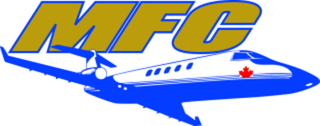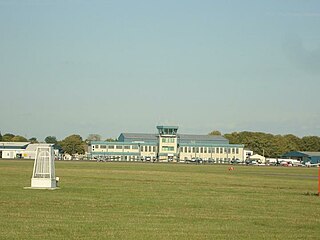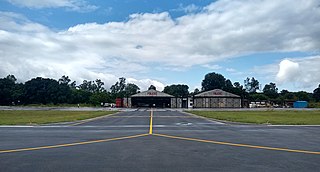
In aviation, instrument flight rules (IFR) is one of two sets of regulations governing all aspects of civil aviation aircraft operations; the other is visual flight rules (VFR).
In aviation, visual flight rules (VFR) are a set of regulations under which a pilot operates an aircraft in weather conditions generally clear enough to allow the pilot to see where the aircraft is going. Specifically, the weather must be better than basic VFR weather minima, i.e., in visual meteorological conditions (VMC), as specified in the rules of the relevant aviation authority. The pilot must be able to operate the aircraft with visual reference to the ground, and by visually avoiding obstructions and other aircraft.

An aircraft pilot or aviator is a person who controls the flight of an aircraft by operating its directional flight controls. Some other aircrew members, such as navigators or flight engineers, are also considered aviators because they are involved in operating the aircraft's navigation and engine systems. Other aircrew members, such as drone operators, flight attendants, mechanics and ground crew, are not classified as aviators.
In aviation, a go-around is an aborted landing of an aircraft that is on final approach or has already touched down. A go-around can either be initiated by the pilot flying or requested by air traffic control for various reasons, such as an unstabilized approach or an obstruction on the runway.

Flight training is a course of study used when learning to pilot an aircraft. The overall purpose of primary and intermediate flight training is the acquisition and honing of basic airmanship skills.

Aviation safety is the study and practice of managing risks in aviation. This includes preventing aviation accidents and incidents through research, educating air travel personnel, passengers and the general public, as well as the design of aircraft and aviation infrastructure. The aviation industry is subject to significant regulation and oversight.
The airline transport pilot licence (ATPL), or in the United States of America, an airline transport pilot (ATP) certificate, is the highest level of aircraft pilot certificate.
A commercial pilot licence (CPL) is a type of pilot licence that permits the holder to act as a pilot of an aircraft and be paid for their work.
Crew resource management or cockpit resource management (CRM) is a set of training procedures for use in environments where human error can have devastating effects. CRM is primarily used for improving aviation safety and focuses on interpersonal communication, leadership, and decision making in aircraft cockpits. Its founder is David Beaty, a former Royal Air Force and a BOAC pilot who wrote "The Human Factor in Aircraft Accidents" (1969). Despite the considerable development of electronic aids since then, many principles he developed continue to prove effective.
Pilot licensing or certification refers to permits for operating aircraft. Flight crew licences are issued by the civil aviation authority of each country, which must establish that the holder has met minimum knowledge and experience before issuing licences. The licence, along with the required class or type rating, allows a pilot to fly aircraft registered in the licence issuing state.
Pilot licensing in the United Kingdom is regulated by the Civil Aviation Authority (CAA).

Private aviation is the part of civil aviation that does not include flying for hire, which is termed commercial aviation. In 2022, private air travel was noted as increasing.

A flight instructor is a person who teaches others to operate aircraft. Specific privileges granted to holders of a flight instructor qualification vary from country to country, but very generally, a flight instructor serves to enhance or evaluate the knowledge and skill level of an aviator in pursuit of a higher pilot's license, certificate or rating.

Morningstar Air Express Inc. is a cargo airline based in Edmonton, Alberta, Canada. It operates a contract all-cargo service from Halifax to Vancouver for FedEx Express within Canada, as well as all-cargo charter services. Its main base is Edmonton International Airport.

The Moncton Flight College (MFC) is a pilot training school based at the Greater Moncton International Airport (CYQM) in Dieppe, New Brunswick, Canada. They have a second location at the Fredericton International Airport (YFC) in Lincoln, NB. In a year, MFC has the capacity to train 450 students between the Moncton and Fredericton Campus. Currently the Moncton Campus offers domestic and international programs with a 260-student capacity and a staff of 55. The Fredericton campus is primarily for Chinese student training with some modular based flight training and has a capacity of 190 students and employs 70 people. Both of the campuses have on-site kitchens and residences. MFC is the largest private flight school in Canada. It is also one of six, out of 150 schools in Canada, to be given integrated status. The college has trained over 20,000 pilots from approximately 70 countries since 1929. MFC has an approved FTU, ATO and AMO from Transport Canada and also has CAAC (China) approval.
Karnal Aerodrome is being operated as a pilot training institute owned and operated by Haryana Institute of Civil Aviation (HICA) under guidance of Civil Aviation Department, Government of Haryana. The flying school is spread over an area of 104 acres and is situated about 3 km east of Karnal in the state of Haryana, India.

CAE Oxford, part of CAE Inc., is an ab initio flight training network. It provides integrated aviation training and resourcing services. Professional airline pilots have been trained at the Oxford Aviation Academy (OAA) flight school since 1961.

The ICON A5 is an American amphibious light-sport aircraft (LSA) designed and produced by ICON Aircraft. A concept aircraft was first flown in 2008, and creation of the production tooling began in December 2012. The first production aircraft made its first flight on July 7, 2014, and made its public debut at EAA AirVenture Oshkosh on July 27, 2014. A year later at AirVenture, it was temporarily donated to the youth group Young Eagles, with the first official A5 customer deliveries occurring in 2016. As of 2019, 100 A5s had been delivered. The aircraft is known for having brought significant excitement and publicity to the LSA industry since its unveiling in 2008, although company legal and financial issues have slowed production since 2016.

Pinjore Airfield is being operated as a pilot training institute owned and operated by Haryana Institute of Civil Aviation (HICA) under guidance of Civil Aviation Department, Government of Haryana. The flying school is spread over an area of 96 acres and is located on Pinjore - Baddi main highway near the cities of Kalka and Pinjore in the Panchkula district of the Indian state of Haryana.
The Haryana Institute of Civil Aviation (HICA) is a Government of Haryana undertaking that operates 4 flying clubs in the state of Haryana to impart pilot training.









